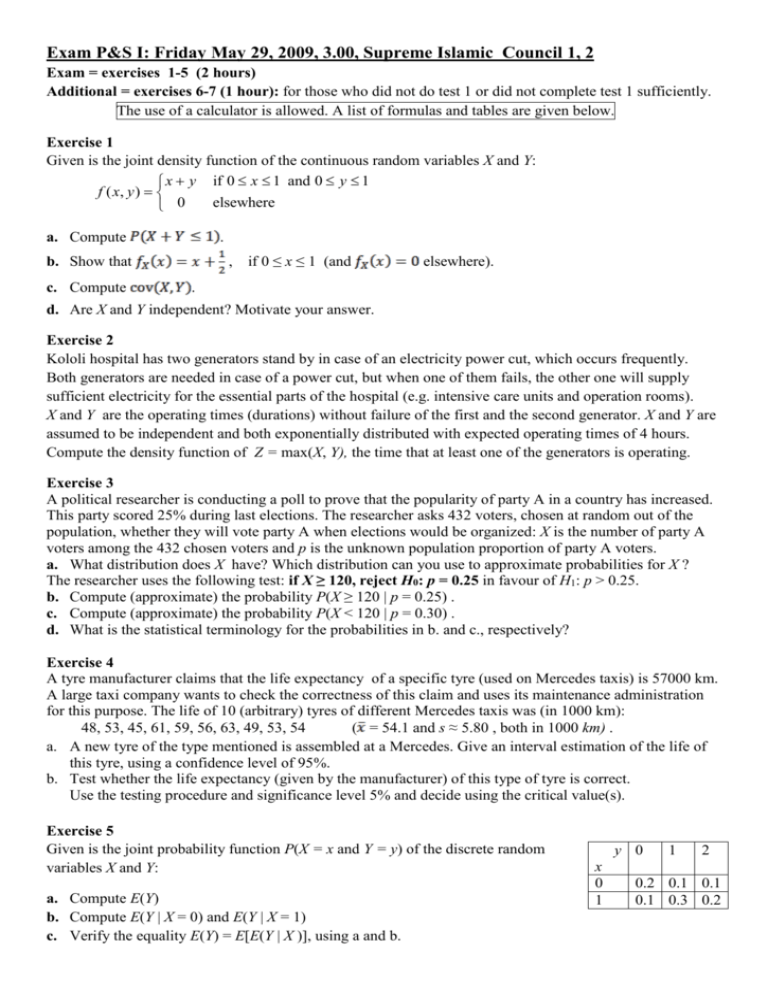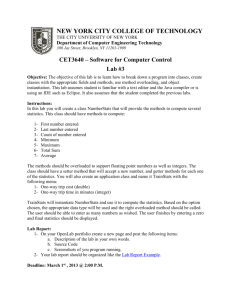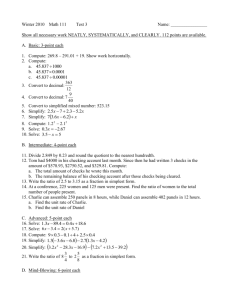Exam, May 29, 2009 and solutions
advertisement

Exam P&S I: Friday May 29, 2009, 3.00, Supreme Islamic Council 1, 2 Exam = exercises 1-5 (2 hours) Additional = exercises 6-7 (1 hour): for those who did not do test 1 or did not complete test 1 sufficiently. The use of a calculator is allowed. A list of formulas and tables are given below. Exercise 1 Given is the joint density function of the continuous random variables X and Y: x y if 0 x 1 and 0 y 1 f ( x, y ) elsewhere 0 a. Compute . , b. Show that c. Compute if 0 ≤ x ≤ 1 (and elsewhere). . d. Are X and Y independent? Motivate your answer. Exercise 2 Kololi hospital has two generators stand by in case of an electricity power cut, which occurs frequently. Both generators are needed in case of a power cut, but when one of them fails, the other one will supply sufficient electricity for the essential parts of the hospital (e.g. intensive care units and operation rooms). X and Y are the operating times (durations) without failure of the first and the second generator. X and Y are assumed to be independent and both exponentially distributed with expected operating times of 4 hours. Compute the density function of Z = max(X, Y), the time that at least one of the generators is operating. Exercise 3 A political researcher is conducting a poll to prove that the popularity of party A in a country has increased. This party scored 25% during last elections. The researcher asks 432 voters, chosen at random out of the population, whether they will vote party A when elections would be organized: X is the number of party A voters among the 432 chosen voters and p is the unknown population proportion of party A voters. a. What distribution does X have? Which distribution can you use to approximate probabilities for X ? The researcher uses the following test: if X ≥ 120, reject H0: p = 0.25 in favour of H1: p > 0.25. b. Compute (approximate) the probability P(X ≥ 120 | p = 0.25) . c. Compute (approximate) the probability P(X < 120 | p = 0.30) . d. What is the statistical terminology for the probabilities in b. and c., respectively? Exercise 4 A tyre manufacturer claims that the life expectancy of a specific tyre (used on Mercedes taxis) is 57000 km. A large taxi company wants to check the correctness of this claim and uses its maintenance administration for this purpose. The life of 10 (arbitrary) tyres of different Mercedes taxis was (in 1000 km): 48, 53, 45, 61, 59, 56, 63, 49, 53, 54 ( = 54.1 and s ≈ 5.80 , both in 1000 km) . a. A new tyre of the type mentioned is assembled at a Mercedes. Give an interval estimation of the life of this tyre, using a confidence level of 95%. b. Test whether the life expectancy (given by the manufacturer) of this type of tyre is correct. Use the testing procedure and significance level 5% and decide using the critical value(s). Exercise 5 Given is the joint probability function P(X = x and Y = y) of the discrete random variables X and Y: a. Compute E(Y) b. Compute E(Y | X = 0) and E(Y | X = 1) c. Verify the equality E(Y) = E[E(Y | X )], using a and b. y 0 x 0 1 1 2 0.2 0.1 0.1 0.1 0.3 0.2 Additional exercises: only for those who did not do test 1 or did not complete test 1 sufficiently. Exercise 6 A deck of playing cards consists of 36 number cards (2-10 in 4 colours: spades, hearts, clubs and diamonds)) and 16 picture-cards (ace, king, queen and jack, each in 4 colours). Suppose we draw 5 cards arbitrarily from the deck (no replacement). a. Compute the probability that all 5 are picture-cards. b. Compute the probability that the first card is an ace and the last a king. Exercise 7 A bank customer has forgotten the last figure of the personal identification number (PIN) of his bank card. He tries to crack his own PIN-code by entering his code with different figures at the end. X is the number of attempts he needs to find his own PIN-code. (Suppose more than 3 trials are allowed, in practise this is not the case) a. Give the appropriate distribution of X and determine E(X). A travelling salesman sells products to (on the average) 15% of the clients he is visiting. One day he has a list of 12 (potential) clients: Y is the number of clients he sells products to. b. Give the appropriate distribution of Y and compute P(Y > EY). The inter arrival time (in seconds) between two consecutive telephone calls at a call centre is modelled as an exponentially distributed Z, having a parameter λ =1/5. c. Compute P(Z ≥ EZ). --------------------------------------------------------------------------------------------------------------------Formulas Exam Probability and Statistics I: Variances: Uniform: , Geometrical: Confidence Intervals: and Hyper geometrical: , P(Tn-1 ≥ c) = Prediction Interval Tests: , if H0: µ = µ0 is true, then If H0: ~ t(n -1) is true, then If H0: p = p0 is true, then Testing proce- P(Tn-1 ≥ c) = 1. The research question (in words) 2. The statistical assumptions (model) ~ N(0, 1) 5. The observed value (of the statistic) 6. The rejection region (for H0) or the p-value 1 2 3 4 5 Total a b c d a b c d a b a b c 2 2 3 2 4 2 3 3 2 3 8 2 2 2 40 3. The hypotheses and level of significance 7. The statistical conclusion dure 4. The test statistic and its distribution 8. The conclusion in words (answer the question) Mark exam = # points / 4 (m) Mark second opportunity test 1 (t1) = #points / 1.8 (t2) Score test 1: t = t2 if t2 ≥ t1 or t = (t1 +t2)/2 if t2 < t1 6 7 Total a b a b c 3 3 4 4 4 18 Final mark Probability and Statistics I: t : m = 1 : 1 and each assignment 5% if advantageous (ass > m). Formula final score = [8m + 8t + max(m, ass 1) + max(m, ass 2) + max(m, ass 3) + max(m, ass 4)]/20. Tables: -, N(0, 1)- and t-distribution Solutions to the exam P&SI: Exercise 1 a. b. c. cov(X, Y) = E(XY) – EX EY = d. X and Y are not independent, because cov(X, Y) 0 (or e.g. ) Exercise 2 Because , we find : if z ≥ 0 (where λ =1/4 ) Exercise 3 a. X ~ B(432, p) => X ~ N(432p, 432p(1-p)) appr. b. p = 0.25: X is appr. N(108, 9) =>) = 1 – 0.8997 = 10.0% c. 1 - 0.8554 = 14.5% in b is the significance level (or the type-I-error probability) and in c is the probability of a type II error if p = 0.3 (1- power of the test if p = 0.3) d. Exercise 4 a. 95% Prediction Interval for X11 : where P(T9 ≥ c) = = 5% => c = 2.262, n = 10, 40.3, 67.9 ), ≈ 54.1 and s ≈ 5.80 b. 1. Is the life expectancy of the tyres not equal to 57000 km? Probability model: the lives X1,..., X10 are independent and all N(µ,σ2)-distributed, with unknown µ and σ2 . 2. Test H 0 : = 57 versus H1 : 57 , = 0.05 3. Test Statistic T = X 57 S / 10 ~ t(9) if H0 is true. 4. Observed value: t = 54.1 57 1.58 5.80 / 10 5. Two sided rejection region : T ≤ - c or T ≥ c, reject H0, where P(T ≥ c | H0) = α/2 =0.025, so c = 2.262 6. t = -1.58 is not in the rejection region: do not reject H0 . 7. Conclusion: at 5% significance level it is not proven that the life expectancy of the tyres is not equal to 57000 km Exercise 5 y 0 1 2 P(Y=y) a. E(Y) = 1 (symmetry) x b. 0 0.2 0.1 0.1 0.4 1 0.1 0.3 0.2 0.6 P(X=x) 0.3 0.4 0.3 1 c. 1 = Exercise 6 Exercise 7 a. X = “Number of attempts” is homogeneous distributed: P(X = x) = 1/10, if x = 1, 2, …,10 E(X) = 5.5 (symmetry) or E(X) = ∑ xP(X=x) = (1 + 2+ …+10)/10 = 5.5. b. X ~ B (12, 0.15) , E(X) = 1.8 => P(X > 1.8) = 1- P(X = 0) - P(X = 1) = 1 c. E(Z) = 1/λ = 5 ≈ 55.7%





